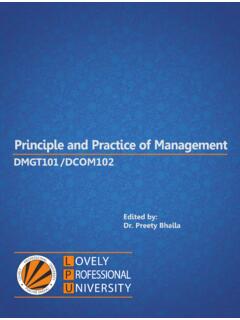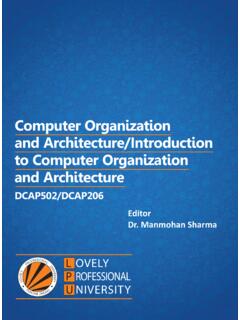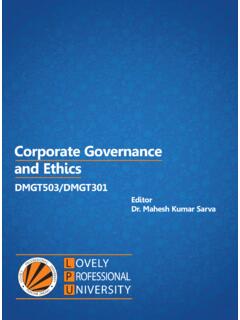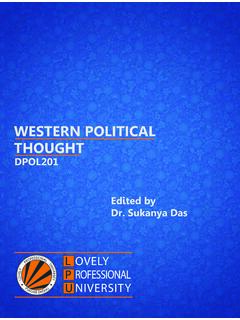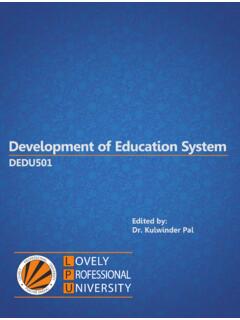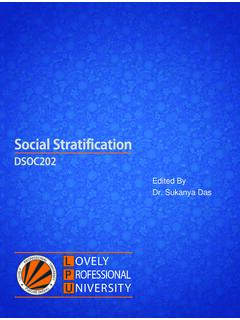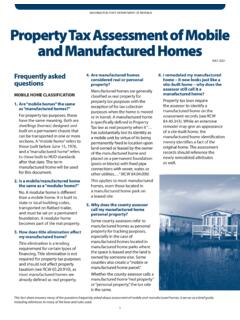Transcription of Services Marketing - LPU Distance Education (LPUDE)
1 Services MarketingDMGT510 Edited by: Hitesh Jhanji Services Marketing Edited ByHitesh Jhanji Printed byEXCEL BOOKS PRIVATE LIMITEDA-45, Naraina, Phase-I,New Delhi-110028forLovely Professional UniversityPhagwara SYLLABUSS ervices MarketingObjectives: The objective of this course is to acquaint the students to the uniqueness of the Services characteristics and itsmarketing implications. The intent of the course is to discuss, measure and analyze several facets in the area of servicesmarketing essential for the success of a service sector No. Discription 1. Introduction to Services Marketing , Understanding Service Characteristics, Product versus Services , Classification of Services , Services Marketing Environment. 2. 7Ps of Services Marketing Mix, Purchase Process for Services . 3. Customer Expectations and Perceptions of Services through Marketing Research, CRM in Services .
2 4. Service Quality issues and Models on Service Quality. 5. The Service Segmentation, Targeting, Positioning a Service in the marketplace, Understanding Positioning Maps, Developing Service Blueprint. 6. Service Product & Operation, Understanding Employees and Customers Role in Service Delivery 7. Pricing of Services , Delivering Service through Intermediaries, distribution growth options, Internationalization in distribution 8. Developing Integrated Communication Program, Designing Servicescapes 9. Competitive Marketing Strategy, Developing Service Recovery Strategies, Managing Demand, Supply and Productivity, Managing waiting Lines, CONTENTUnit 1:Introduction to Services Marketing Tanima Dutta, Lovely Professional University1 Unit 2:Service Marketing Environment Tanima Dutta, Lovely Professional University20 Unit 3:The Service Marketing Mix and Purchase Process Tanima Dutta, Lovely Professional University37 Unit 4:Customer Expectations and Perceptions of Services through Marketing Research Tanima Dutta, Lovely Professional University56 Unit 5:Customer Relationship Management in Services Sukhpreet Kaur, Lovely Professional University80 Unit 6:Service Quality Pretty Bhalla, Lovely Professional University99 Unit 7.
3 Service Segmentation and Targeting Pretty Bhalla, Lovely Professional University120 Unit 8:Market Positioning and Blueprinting in Services Pretty Bhalla, Lovely Professional University138 Unit 9:Service Product and Operation Gopika Juneja, Lovely Professional University154 Unit 10:Role of Employees and Customers in Service Delivery Gopika Juneja, Lovely Professional University182 Unit 11:Pricing of Services Gopika Juneja, Lovely Professional University196 Unit 12:Distribution of Services Gopika Juneja, Lovely Professional University214 Unit 13:Promotions and Servicescapes in Services Hitesh Jhanji, Lovely Professional University234 Unit 14:Service Strategies Hitesh Jhanji, Lovely Professional University256 LOVELY PROFESSIONAL UNIVERSITY1 Unit 1: Introduction to Services MarketingNotesUnit 1: Introduction to Services Service Intangible than Production and Standardised and vs.
4 Of ReadingsObjectivesAfter studying this unit, you will be able to: Describe the concept of Services Marketing Define Services Discuss the service characteristics Distinguish between products and Services Classify servicesIntroductionAs India moves increasingly toward a Services economy, marketers need to know more aboutmarketing service products. On a simplistic note, one can say that Services are activities orbenefits that one party can offer to another that are essentially intangible and do not result in theownership of anything. Thus we see how Services are different from the past decade Services have increasingly assumed an important role in the Indianeconomy. Ever since this trend was set in the nineties, Services have gained dominance. Thecompetition, simultaneously, in service organisations, is becoming intense and severe. As aresult these organisations have to have a more professional approach to managing theirbusinesses.
5 Perhaps it is in this context that the role of Marketing is gaining importance inservice organisations. In this unit, you will be introduced to the concept of Services . Tanima Dutta, Lovely Professional University2 LOVELY PROFESSIONAL UNIVERSITYS ervices ServicesOne of the first to define Services was the American Marketing Association, which, as early as in1960, defined Services as activities, benefits, or satisfactions which are offered for sale, orprovided in connection with the sale of goods. This definition took a very limited view onservices as it proposed that Services are offered only in connection with the sale of other definition which was proposed, in 1963, by Regan suggested that Services representeither intangibles yielding satisfaction directly (transportation, housing), or intangibles yieldingsatisfaction jointly when purchased either with commodities or other Services (credit, delivery).
6 For the first time Services were considered as pure intangibles capable of providing satisfactionto the customer which could be marketed like tangible Judd defined service as a market transaction by an enterprise or entrepreneur where theobject of the market transaction is other than the transfer of ownership of a tangible commodity .Lehtinen, in 1983, defined Services as an activity or a series of activities which take place ininteractions with a contact person or a physical machine and which provides consumersatisfaction. Kotler and Bloom, in 1984, defined Services as any activity or benefit that one party can offer toanother that is essentially intangible and does not result in the ownership of anything. Itsproduction may or may not be tied to a physical product. Gummesson highlighting the intangible nature of Services defined Services as something whichcan be bought and sold but which you cannot drop on your foot.
7 This definition also pointedout one basic characteristic that the Services can be exchanged even though they are not to Gronross, a service is an activity or series of activities of more or less intangiblenature that normally, not necessarily, take place in interactions between the customer andservice employees and/or physical resources or goods and/or system of the service provider,which are provided as solution to customer problems. CaseletMyths about Service IndustriesThere are certain myths about Services sector. It is because of these myths that peopleare unable to relate the role and contribution of the Services sector in the first myth is that a service economy produces Services at the expense of other fact is that many service industries are major purchasers of manufactured goods. Takethe example of airlines, fast food outlets, educational institutions, etc.
8 , which buy so muchof manufactured second myth is that service production is primarily labour intensive. In fact, a numberof service sectors like healthcare, hospitality, etc., are capital intensive. Productivity aretherefore equally important in service organisations as returns on capital employed willbe one of the major determinants of third myth about Services is that people satisfy their product needs before the need forservices. This is also not true. Research findings of a study revealed that people valueservices as much as products; however, they may buy Services in a less cyclical way, ascompared to LOVELY PROFESSIONAL UNIVERSITY3 Unit 1: Introduction to Services MarketingNotesThe fourth myth about the Services sector is that service businesses are cottage industries and service jobs are low paying. If you check the list of Fortune 500 companies you will besurprised to see the number of service companies figuring in this other myth about the service sector is that Services are only offered by the governmentsector.
9 The fact is that on the one hand public Services , like telephones, health care, powergeneration and distribution, etc., are being privatised and on the other hand large enterprisesare entering into Services sector. Take the example of Escorts into health care, Tatas inpower distribution, etc. In fact the service organisations are quite varied and differentfrom each category includes the public agency sector for example post offices, police and firedepartments, water and electricity authorities, etc. The second group is made up of theprivate non-profit sector running charities, foundations, old age homes or various societiesinvolved in issues related to women, literacy, family welfare, etc. Next comes the businesssector comprising banks, hotels, airlines, travel agencies, tour operators, courier Services ,insurance, consultancy legal management or medical.
10 Lastly, it is the sector which providesservices to those involved in manufacturing. This includes those firms providing securitypersonnel, accountants and auditors, computer operators and software consultants whichhelp manufacturing firms in their addition, there are a number of other types of Services which are emerging in thewestern society. These range from, on a charge, the availability of a baby sitter to a groupof hippies making the party colourful. In India also such Services are emerging whetherthey are a troupe of young boys and girls doing a music-cum-dance show on a birthday orwedding, house maintenance Services , real estate brokers, security, definition takes into account the following important features of Services : Services are by and large activities or they are series of activities rather than things. As a result Services are intangible.
